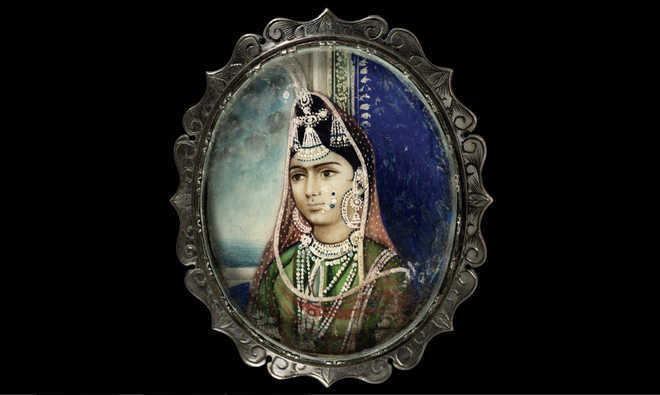
The story of the Sikh Maharani’s jewels and riches runs parallel to the story of her life
Shyam Bhatia
The beauty and valour of independent Punjab’s last ruling queen will be invoked in a soon-to-be-held auction expected to attract leading Indian, British and US collectors of treasures of 19th-century Punjab.
Maharani Jindan Kaur (popularly known as Rani Jindan) was the last and the youngest wife of Maharaja Ranjit Singh, and mother of Maharaja Duleep Singh, who was forced from the throne when the British East India Company annexed the independent kingdom of Lahore. In many ways, she was a role model for the legendary Rani Laxmi Bai, the Rani of Jhansi, who also resisted the British until she was killed in 1858. However, whereas Laxmi Bai died from battle wounds, Jindan reigned for three years as Queen Regent of Punjab. Her aim was to protect the legacy of her only child and infant Maharaja, Duleep Singh, whose Sikh empire stretched from Kabul to Kashmir and the borders of Delhi. The greedy British forces gathering on the borders of Punjab were so concerned about her power and determination that they started a propaganda campaign describing her as no better than a prostitute, seductress and the ‘Messalina of the Punjab’, a reference to the promiscuous third wife of Roman Emperor Claudius.
The campaign continued as the British implemented a policy of divide and rule, playing off Rani Jindan against the Supreme Council of the Khalsa and the coterie of powerful Sikh generals who had promised to protect the kingdom.
In the end, Rani Jindan was outwitted by Governors General Lord Hardinge and Lord Dalhousie, who had her imprisoned until she escaped to a life of exile in Nepal. A famous note she left for her British jailors read: “You put me in a cage and locked me up. For all your locks and your sentries, I got out by magic... I had told you plainly not to push me too hard — but don’t think I ran away. Understand well, that I escape by myself unaided... don’t imagine I got out like a thief.”
While his mother tried to outwit the British, Duleep Singh was allowed to continue as a puppet Maharaja until he too was deposed, in 1849, converted to Christianity and packed off to England.
None of this could have been anticipated when Rani Jindan was born in 1817 to Manna Singh Aulakh, the royal kennel keeper from Chachar village in Gujranwala district north of Lahore. Legend has it that Manna Singh sang praises of his stunning daughter to the one-eyed Maharaja Ranjit Singh, who demanded that his 18-year-old daughter present herself at court.
Ranjit fell head over heels in love with her, sending a sword and arrow to Chachar as a symbol of marriage. She became his newest wife, future queen regent and mother of the last Sikh Maharaja. Significantly, a 61.8 cm gold thread-embroidered quiver and 28.8 cm long bow holder set in red velvet is one of the items being offered next month by London auctioneers Bonhams in their sale of Sikh Treasures and Arts of the Punjab. It comes with a leather belt embroidered with a band of rosettes and terminates in a circular iron buckle, green velvet suspension loop to reverse with two sets of four tassels to one side. Bonhams explain how these symbols of sovereignty were all presented to Dalhousie in October 1851 by the Nine Sovereign Chiefs of the then protected Sikh states.
Rani Jindan lived in a Lahore that was the envy of the Western world. Its mix of palaces, gurdwaras, mosques, havelis and shops was distributed around the renowned Lahore Fort, or Shahi Qila, that dates back to the time of Akbar. Pictures of the 19th century city are contained in an album of photographs taken by Lockwood Kipling, father of Rudyard Kipling. That is also part of the Sikh Treasures sale.
British explorer Alexander Burns, who visited the royal apartments in 1831, described the opulence of a bed where the ‘frame-work, posts and legs were covered entirely with gold and the canopy was one sheet of the same precious metal. It stood on footstools raised about ten inches from the ground, which were also made of gold. The curtains were of Kashmir shawls, near around it stood a chair of gold and in one of the upper rooms of the palace, we saw the counterpart of these costly ornaments. The little room in which we sat was superbly gilded and the side which was next to the court was closed by a screen of yellow silk.”
When the 18-year-old Maharani arrived in the city four years later, it was a byword for luxury living — with the Sheesh Mahal taken over for the Maharaja’s private apartments, next to a private shrine where the Guru Granth Sahib was read every day. The Badshahi Mosque built by Aurangzeb was used as the ammunition depot for the Sikh army. However, the biggest surprise was Moti Masjid where the Maharaja kept an astounding collection of gold, silver and jewels, including a necklace of emeralds and pearls gifted to the Maharani, also part of the Sikh Treasures sale.
The necklace is described as consisting of six polished emerald beads, one later converted to a pendant, each bead gold mounted and fringed with seed-pearl drop tassels, with gold clasp, in fitted cloth covered case, the inside of the lid inscribed: “From the Collection of the Court of Lahore formed by HH the Maharajah Runjeet Singh and lastly worn by Her Highness The Late Maharanee Jeudan Kower.”
Oliver White, head of Indian and Islamic Department at Bonhams, says, “The gold, pearl and emerald necklace from the collection of the court of Lahore is one of the most important pieces remaining from the Sikh Empire. The necklace belonged to a remarkable woman who endures as an extremely important figure from Sikh history.”
Rani Jindan’s jewels have always been of interest, but the timing of next month’s sale is significant. It follows the successful Empire of the Sikhs exhibition presented by the UK Punjab Heritage Association, and the recent screening of a BBC TV documentary about Maharaja Duleep Singh, entitled The Stolen Maharajah. Three months ago (May), a Sikh Arts Exhibition, was launched in the city of Leicester.



























